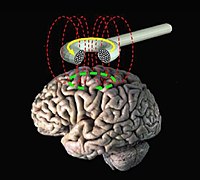
Photo from wikipedia
Noninvasive Vagus Nerve Stimulation for Treatment of Indomethacin-Sensitive Headaches Trigeminal autonomic cephalalgias (TACs) are a group of primary headache disorders that are characterized by attacks of unilateral pain of varying… Click to show full abstract
Noninvasive Vagus Nerve Stimulation for Treatment of Indomethacin-Sensitive Headaches Trigeminal autonomic cephalalgias (TACs) are a group of primary headache disorders that are characterized by attacks of unilateral pain of varying duration and prominent, ipsilateral cranial autonomic symptoms, such as lacrimation, conjunctival injection, nasal congestion, rhinorrhea, or periorbital edema. The TACs include cluster headaches, paroxysmal hemicrania, hemicrania continua, and short-lasting unilateral neuralgiform headache attacks with conjunctival injection and tearing or cranial autonomic symptoms.1 Paroxysmal hemicrania (PH) attacks last 2 to 30 minutes and typically occur several times per day.1,2 Hemicrania continua (HC) is characterized by continuous pain with exacerbations lasting for hours or days.3 Both are defined by their response to indomethacin; a high dose of 225 mg daily or greater may be needed1 and lifelong treatment is frequently required. Unfortunately, indomethacin is often poorly tolerated because of adverse effects, such as nausea, abdominal pain, or gastric bleeding. Transcutaneous stimulation of the vagus nerve with the GammaCore (electroCore, LLC) has been effective for the acute treatment of episodic cluster headaches in 2 randomized shamcontrolled trials,4,5 raising the possibility that this treatment might be effective for other TACs including HC.6 We began treating patients with PH or HC who were unable to tolerate
Journal Title: JAMA Neurology
Year Published: 2017
Link to full text (if available)
Share on Social Media: Sign Up to like & get
recommendations!